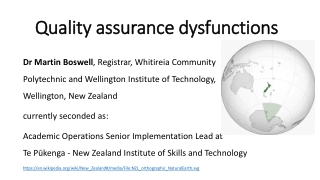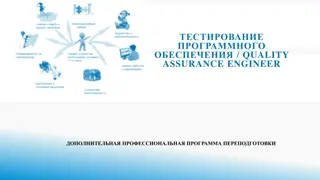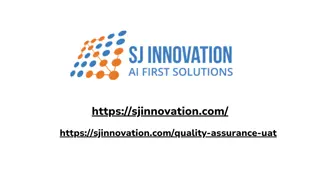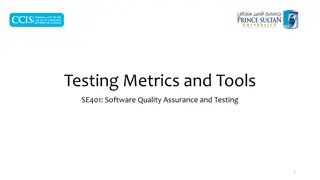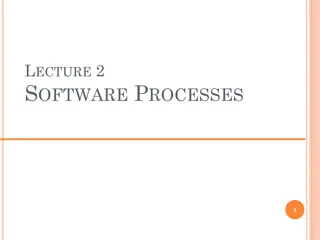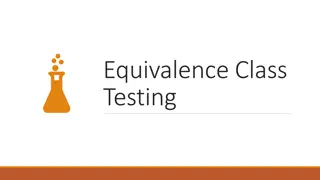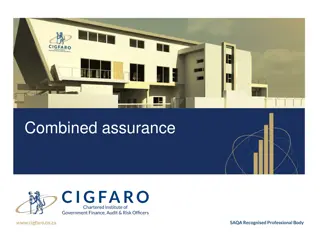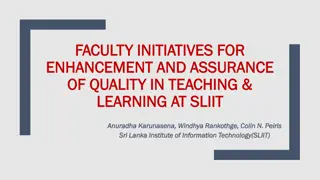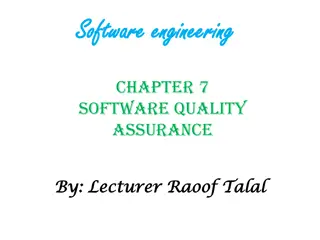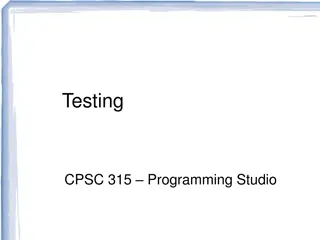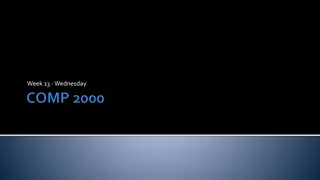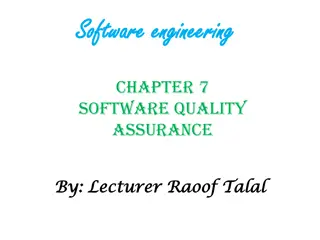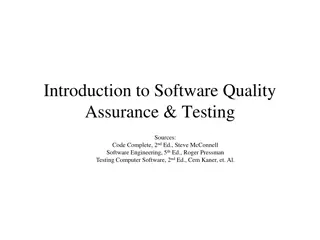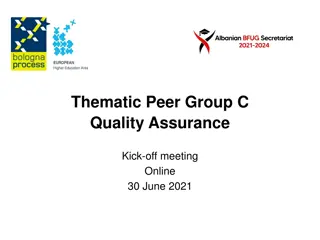Software Testing & Quality Assurance Lecture Series
Dennis Mumaugh leads a comprehensive lecture series on software testing and quality assurance, covering key topics such as course information, basic contact details, lecture notes, and course materials availability through Desire2Learn. The course mailing list and supplemental reading materials are also highlighted in this detailed course overview.
Download Presentation

Please find below an Image/Link to download the presentation.
The content on the website is provided AS IS for your information and personal use only. It may not be sold, licensed, or shared on other websites without obtaining consent from the author.If you encounter any issues during the download, it is possible that the publisher has removed the file from their server.
You are allowed to download the files provided on this website for personal or commercial use, subject to the condition that they are used lawfully. All files are the property of their respective owners.
The content on the website is provided AS IS for your information and personal use only. It may not be sold, licensed, or shared on other websites without obtaining consent from the author.
E N D
Presentation Transcript
Are you in the right course? SE 433/333 Software Testing & Quality Assurance March 28, 2017 SE 433: Lecture 1 1 of 98
SE 433/333 Software Testing & Quality Assurance Dennis Mumaugh, Instructor dmumaugh@depaul.edu Office: CDM, Room 428 Office Hours: Tuesday, 4:00 5:30 March 28, 2017 SE 433: Lecture 1 2 of 98
Administrivia: Introduction Dennis Mumaugh Undergraduate: BSEE University of California, Berkeley MS Computer Science University of Maryland Ph.D. Studies University of Maryland Teaching at DePaul since September 2000 Work Senior Engineer National Security Agency ARPANet Pioneer, Unix Technology Transfer Member of the Technical Staff Bell Labs/Lucent Technologies Unix Development Current Engineering IS&R Systems Knowledge Based Systems Software Tools and OO Technology Interests Operating Systems and System Programming Software Productivity, Compilers and Software Metrics Software Engineering March 28, 2017 SE 433: Lecture 1 3 of 98
Administrivia: Basic Information Contact Information: Email: dmumaugh@depaul.edu Phone: 630-983-1221 (10:00 am - 11:00 pm) except just before class (After 3pm) Office Hours Tuesday: 4:00 pm to 5:30 pm, Loop, CDM, Room 428 By arrangement March 28, 2017 SE 433: Lecture 1 4 of 98
Administrivia: Basic Information Class home page http://condor.depaul.edu/dmumaugh/classes/SE433S17, contains syllabus and schedule, lecture notes, homework, more reading material About the Lecture Notes look at notes section of the slides Also look at the expanded readings page: http://condor.depaul.edu/dmumaugh/readings/SE433readings.html Desire2Learn: Course materials, assignments, assignment submissions, assignment solutions, examinations and quizzes and grades will be available on the Desire2learn https://d2l.depaul.edu/ Email All students are expected to have an email address. Please make sure it is valid and make sure Campus Connection has the current email address. March 28, 2017 SE 433: Lecture 1 5 of 98
Administrivia: Basic Information Course mailing list: se433@mailman.depaul.edu To subscribe to the list or unsubscribe from it, go to http://mailman.depaul.edu/mailman/listinfo/se433. I ll bulk subscribe on Saturday. If necessary, update your spam filter to accept messages from the mailing list. Unless your message is personal, send it to the course mailing list! I will respond to questions related to the lectures and assignments. You are also encouraged to respond to other students questions. The mailing list is archived. You may subscribe to a digest. Last minute information will go to the mailing list March 28, 2017 SE 433: Lecture 1 6 of 98
Administrivia: reading materials Primary Textbook Software Testing and Analysis: Process, Principles and Techniques, by Mauro Pezze and Michal Young References The Art of Software Testing, Second Edition by Glenford J. Myers et al Available in e-book through library Software Engineering: A Practitioner's Approach, 6th ed by Roger S Pressman (Chapters 13 and 14) Lecture notes and supplementary materials Available on D2L March 28, 2017 SE 433: Lecture 1 7 of 98
Administrivia: reading materials A note on reading list You are not expected to read all of the material on the reading list. Look at the various articles as you have time. Many say the same thing but with a different perspective. Don't get overwhelmed in reading March 28, 2017 SE 433: Lecture 1 8 of 98
Administrivia: Course structure Ten classes + Midterm Exam + Final Exam Weekly reading, assignments (10) Class structure: lecture (with short break near the middle). Topics and reading assignments are on the class web page March 28, 2017 SE 433: Lecture 1 9 of 98
Administrivia: required software Access to MS Word and PowerPoint (or equivalent) Java Java development and testing software: Eclipse, JUnit, Ant, Cobertura. March 28, 2017 SE 433: Lecture 1 10 of 98
Administrivia: Support Technical questions can be addressed during office hours or by email Use the mailing list for all technical questions Provide appropriate support to each other I do not preview homework, but I will answer questions or make suggestions to generic problems If you contact me by e-mail Please include your name and the course number in all correspondence March 28, 2017 SE 433: Lecture 1 11 of 98
Administrivia: Miscellany Communications development: An essential part of this course is communicating your ideas in prose, as well as in technical graphical artifacts. The ability to communicate clearly and effectively is a skill that will pay off both in and out of class. Motivation from a recent NPR business report: Robert Half surveyed their corporate customers concerning resumes they had received. Corporate reviewers spent about 10-15 seconds deciding whether to examine the resume further. They instantly tossed the resume if they detected any grammatical or spelling errors. Treat your coursework as if it were being reviewed by the manager who does your performance review and sets your salary. March 28, 2017 SE 433: Lecture 1 12 of 98
Administrivia: Miscellany Intellectual property issues: All material in this course is property of either the instructor or Xiaoping Jia. You are permitted to download and print copies of the material. You are not permitted to redistribute the material in any form. Plagiarism: All individual assignments must represent your own work. It's a great idea to get together in study groups to discuss the problems, but you should then do the assignments individually. Plagiarism is to take and use as one s own, or copy without acknowledgement, the works of another person. The provider of such material can be ruled equally culpable. If you hand in late homework with prior permission, it must be your own work, not a copy of the solutions presented in class. March 28, 2017 SE 433: Lecture 1 13 of 98
Administrivia: Miscellany There will be a lot of ambiguity and lack of firm direction in the assignments and the information. That is typical of much of engineering. This requires you to provide your own experience. Or to research and discover your information. Using previous solutions/techniques will not necessarily work. You may have to invent something. Understanding a problem (statement): An essential part of this course is understanding written material, ideas in prose. The ability to understand a document, to "read between the lines", is a skill that will pay off both in and out of class. Areas of concern: Projects are implemented with the wrong features. Students answer the wrong question on a test. People confuse the subsystems of a design. People do not read, really read things. March 28, 2017 SE 433: Lecture 1 14 of 98
Administrivia: Feedback/Participation Feedback/Participation Share your thoughts Ask questions wave your hand forcefully to get my attention Speak loudly so all can hear Give me verbal and non-verbal feedback Don't just sit there . . . nod, smile, frown, shake your head Make sure your email address is correct and works March 28, 2017 SE 433: Lecture 1 15 of 98
Homework logistics Homework must be submitted via Desire2Learn by 11:59 PM Chicago Time on the assignment due date. Do not rely on the deadline, clocks differ. Be early. Submit MS Word or Adobe PDF files only [I accept either format of MS Word] No extra credit assignments. Late Policy Late assignments will not be accepted except for special circumstances. March 28, 2017 SE 433: Lecture 1 16 of 98
Grading Attendance & Assignments Attendance 10% In-class students: attendance taken during class On-line students: must watch each lecture within 6 days Submit attendance confirmation Assignments and projects (individual) SE333 50% SE433 45% Including several programming projects March 28, 2017 SE 433: Lecture 1 17 of 98
Grading Exams & Final Paper Mid-term exam 20% Final exam 20% Final paper 5% (SE433 only) No late submission will be accepted. March 28, 2017 SE 433: Lecture 1 18 of 98
Administrivia: assessment Regular assignments (10) Midterm examination Final examination Each of the above will be weighted as follows: Attendance 10% Assignments and projects 50% for SE333 45% for SE433 Mid-term exam 20% Final exam 20% Final take-home exam, a short paper 5% SE433 only, Grading will be done on the usual 60/70/80/90 bands but will be adjusted to account for clustering and banding of scores. Bands may be adjusted if there seems to be a systemic bias to the scores. March 28, 2017 SE 433: Lecture 1 19 of 98
Assignments Read the relevant chapters in the textbook and the relevant reference materials. Understand all the materials covered in the lecture notes. Use the mailing list for questions and discussions. March 28, 2017 SE 433: Lecture 1 20 of 98
Course Specific Information March 28, 2017 SE 433: Lecture 1 21 of 98
Prerequisites Data Structures II (CSC 301, 403, 383, 393), or Object-Oriented Modeling (SE430) Proficient in programming and data structures Assignments will use Java Familiar with object-oriented modeling and principles Familiar with software development processes March 28, 2017 SE 433: Lecture 1 22 of 98
Course Objectives Understand how to achieve high quality insoftware development Study the processes, techniques, and tools for software testing Focus on software testing and analysis basic principles and techniques underlying theory organizational and process issues March 28, 2017 SE 433: Lecture 1 23 of 98
Learning Outcomes Applications of techniques and tools at the module and system levels Understanding of the techniques, processes, and tools at the project and organization levels Emphasis practical techniques to achieve an acceptable level of quality at an acceptable cost. realistic strategies for reliable and cost-effective software testing. March 28, 2017 SE 433: Lecture 1 24 of 98
Some Topics Performance testing Web application testing Security testing Graphical user interface (GUI) testing Usability testing Fault-based testing Planning and monitoring the software quality process Testing of object-oriented software Introduction to software testing Functional testing Structural testing Test case selection Inspection Static analysis Unit testing Test automation and tools Integration and system testing Regression testing We will cover a subset of the above. March 28, 2017 SE 433: Lecture 1 25 of 98
Engineering Methodology What is engineering and how does it differ from science? Engineering is the application of science to the needs of humanity. This is accomplished through the application of knowledge, mathematics, and practical experience to the design of useful objects or processes in a cost effective way. One of the objectives of this course is to teach some of the methodology of engineering Understanding the problem How to approach a problem Developing and following requirements Writing and reading specifications Analyzing a problem Designing a solution Verifying each step Testing the design against the original problem statement March 28, 2017 SE 433: Lecture 1 26 of 98
Surviving SE433 Make sure you read things, sometimes more than once. People do not seem to read assignments and web pages (or do not follow instructions). The pace is quick. The intent of the course is to learn by doing, not by reading; but there is a lot of information to process. Read the assignments carefully. Note special requirements, such as formats and use of predefined templates! Start your assignments right after they are handed out (assigned). They will take some time and starting on the night before it is due is not a good strategy. Reading list: Is it required? No. Is it useful? Yes, especially if you are serious about a career in software development. The articles are usually short but informative. Most are supplemental useful for understanding but the notes cover the major points. Reading should be done in parallel with the lectures. Pace yourself. Remember: This too shall pass. March 28, 2017 SE 433: Lecture 1 27 of 98
SE 433 Class 1 Topics: Introduction and Overview: Class Logistics and Administrivia; Introduction to Software Testing Reading Pezze and Young: Chapters 1-4 March 28, 2017 SE 433: Lecture 1 28 of 98
Thought for the Day Software Testing takes at least twice as long as estimated. March 28, 2017 SE 433: Lecture 1 29 of 98
On Testing For the Snark s a peculiar creature, that won t Be caught in a commonplace way. Do all that you know, and try all that you don t: Not a chance must be wasted to-day! Lewis Carroll The Hunting of the Snark, an Agony in Eight Fits (1876) March 28, 2017 SE 433: Lecture 1 30 of 98
Why Programs fail In Federalist 51, James Madison wrote: If men were angels, no government would be necessary. If he lived today, Madison might have written: If software developers were angels, debugging would be unnecessary. March 28, 2017 SE 433: Lecture 1 31 of 98
Why Programs fail Congratulations! Your code is complete. It compiles. It runs Your program fails. How can this be? There is a defect in the code. When the code is executed, the defect causes bad behavior, which later becomes visible as a failure. Before a program can be debugged, we must set it up such that it can be tested that is, executed with the intent to make it fail. The first step in debugging is to reproduce the problem in question that is, to create a test case that causes the program to fail in the specified way. The first reason is to bring it under control, such that it can be observed. The second reason is to verify the success of the fix. Now you will have the fun of testing and debugging! March 28, 2017 SE 433: Lecture 1 32 of 98
Myth Busters Software Testing March 28, 2017 SE 433: Lecture 1 33 of 98
Myth #1 in Software Testing Q: What is the objective of software testing? A: Testing is to show that there are no errors/bugs/defects in the software. Fact: No!! The main objective of testing is to discover defects. Testing is a destructive activity. March 28, 2017 SE 433: Lecture 1 35 of 98
Myth #2 in Software Testing Q: What is the objective of software testing? A: Testing is to ensure that the software does what it is supposed to do. Fact: Only partly true. Testing is also to ensure the software does not do what it is not supposed to do. March 28, 2017 SE 433: Lecture 1 37 of 98
Myth #3 in Software Testing Q: How challenging is software testing? A: Testing is easier than design and implementation. Fact: Must consider all possible scenarios. Implied and unstated requirements and threats. Must be imaginative and creative. March 28, 2017 SE 433: Lecture 1 39 of 98
Myth #4 in Software Testing Q: How challenging is software testing? A: Testing is an extremely creative and intellectually challenging task. March 28, 2017 SE 433: Lecture 1 41 of 98
What is Software Testing ? Software testing is the process of executing a program with the intent of finding bugs. March 28, 2017 SE 433: Lecture 1 42 of 98
Cost of Software Errors Estimated 50% of each software project spent on testing (spans from 30% to 80%) Very rough approximation money spent on testing + cost of remaining errors = 66% of size of software industry Remark: At Ericsson: 35% of code is test cases! March 28, 2017 SE 433: Lecture 1 43 of 98
Failure and Specification Some failures are obvious obviously wrong output/behavior non-termination Crash freeze ...but most are not! In general, what constitutes a failure, is defined by a specification! Correctness is a relative notion B. Meyer, 1997 March 28, 2017 SE 433: Lecture 1 44 of 98
Why Does Software Testing Matter? March 28, 2017 SE 433: Lecture 1 45 of 98
Economic Impact NIST, The Economic Impacts of Inadequate Infrastructure for Software Testing Inadequate software testing costs the US alone around $59.5 billion annually Better approaches could cut this amount by $22.2 billion We want our programs to be reliable Testing is how, in most cases, we find out if they are March 28, 2017 SE 433: Lecture 1 46 of 98
Launch of MS Windows 98 Bill Gates and Blue Screen of Death Image:Windows XP BSOD.png video March 28, 2017 SE 433: Lecture 1 48 of 98
Why Do We Test? Testing is expensive. So are failures! What do we gain from that cost? Finding bugs Leading to Fixing bugs Raising the quality of the program or system we are testing March 28, 2017 SE 433: Lecture 1 49 of 98
Why Do We Test? Kinds of testing Smoke test. , aka Hello World! Check handling of inputs Illegal inputs text instead of integers Impossible inputs floating vs. integer Outrageous values infinities, max and min values Not in domain negative numbers, values outside specifications Input errors wrong input, e.g. mis-spellings Stress test multiple inputs without restart run program for long periods of time March 28, 2017 SE 433: Lecture 1 50 of 98
A Case Study: Ariane 5 Launch Vehicle European expendable launch system Double the payload capacity of its predecessor Ariane 4 113 successful launches, 3 failures Flight 501, maiden launch, June 4, 1996,12:34pm Ariane 5 mock-up March 28, 2017 SE 433: Lecture 1 51 of 98
Case Study Ariane 5: What Happened? T0 - T0 + 36s : normal Within SRI 2: BH (Bias Horizontal) > 215 convert_double_to_int(BH) fails! exception SRI -> crash SRI 2 & 1 OBC disoriented angle > 20 , huge aerodynamics constraints boosters separating... T0 + 39s: self destruction cost: 500M March 28, 2017 SE 433: Lecture 1 52 of 98
Case Study Ariane 5: Why Did It Happen? Not a programming error unprotected conversion = design decision (~1980) Not a design error Justified against Ariane 4 trajectory & RT constraints Problem with integration testing Theoretically detectable. But huge test space vs. limited resources Furthermore, SRI useless at this stage of the flight! Reuse of a component with a hidden constraint Precondition : abs(BH) < 32768.0 Valid for Ariane 4, but no longer for Ariane 5 More powerful rocket March 28, 2017 SE 433: Lecture 1 53 of 98
Case Study Ariane 5: Lessons Learned in Software Eng. Test! Test! Test! Test! Even when the code is reused. When reuse, ensure the assumptions are still valid. When write reusable code, document the assumptions. Write fail-safe code. Do not propagate errors. March 28, 2017 SE 433: Lecture 1 54 of 98
Trade-Offs of Cost and Failures Total Cost of Quality (CoQ) = Cost of Conformance (CoC) + Cost of Non-Conformance (CoNC) Cost of Conformance Prevention: quality planning, investment in tools, quality training Appraisal: testing, inspection Cost of Non-Conformance Internal failures: rework External failure: liability, loss of properties, loss of lives March 28, 2017 SE 433: Lecture 1 55 of 98



